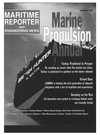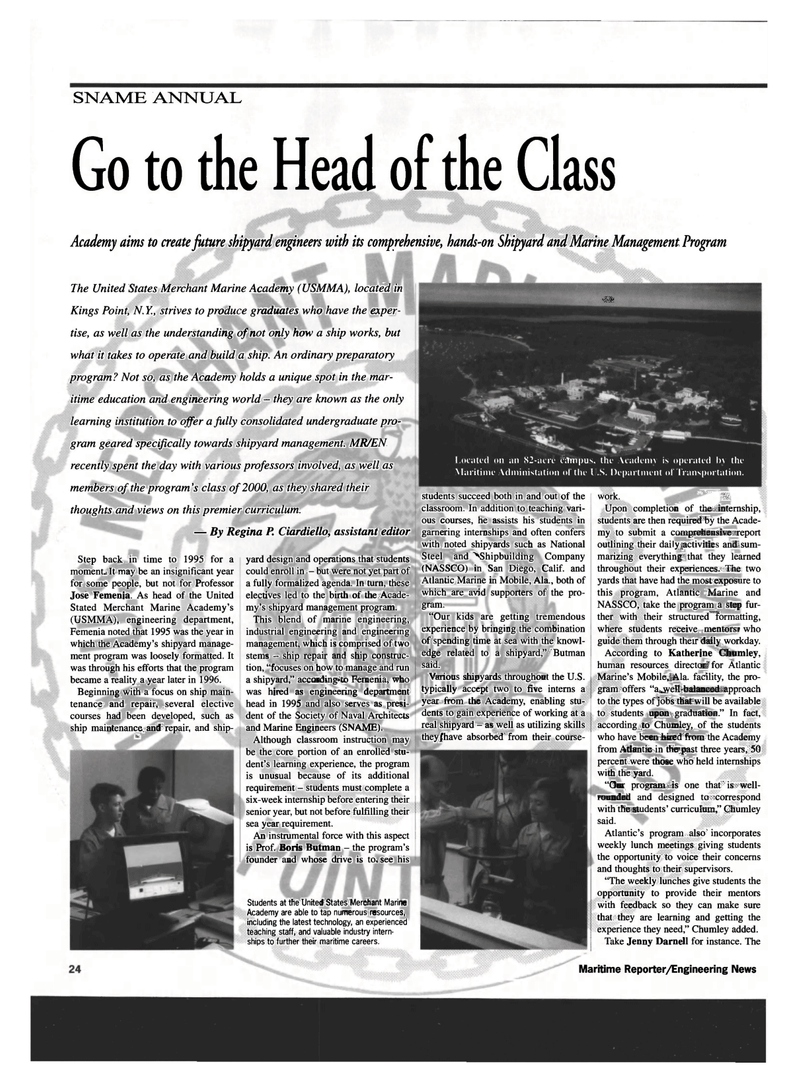
Page 26: of Maritime Reporter Magazine (September 1999)
Read this page in Pdf, Flash or Html5 edition of September 1999 Maritime Reporter Magazine
SNAME ANNUAL 1.oca ted on an 82-acre cflmpus, the Acadcnn is operated In the
Maritime Administation of the l.S. Department of Transportation. members of the program's class of2000, as they shared their thoughts and views on this premier curriculum. — By Regina P. Ciardiello, assistant editor
Step back in time to 1995 for a moment. It may be an insignificant year for some people, but not for Professor
Jose Femenia. As head of the United
Stated Merchant Marine Academy's (USMMA), engineering department,
Femenia noted that 1995 was the year in which the Academy's shipyard manage- ment program was loosely formatted. It was through his efforts that the program became a reality a year later in 1996.
Beginning with a focus on ship main- tenance and repair, several elective courses had been developed, such as ship maintenance, and repair, and ship- ; - yard design and operations that students could enroll ini- but were not yet part of a fully formalized agenda. In turn, these electives led to the birth of the Acade- my's shipyard management program.
This blend of marine engineering, industrial engineering and engineering management, which is comprised of two stems - ship repair and ship construc- tion, "focuses on how to manage and run a shipyard," according to Femenia, who was hired as engineering department head in 1995 and also serves as presi- dent of the Society of Naval Architects and Marine Engineers (SNAME).
Although classroom instruction may be the core portion of an enrolled stu- dent's learning experience, the program is unusual because of its additional requirement - students must complete a six-week internship before entering their senior year, but not before fulfilling their sea year requirement.
An instrumental force with this aspect is Prof. Boris Butman - the program's founder and whose drive is to see his
Students at the United States Merchant Marine
Academy are able to tap numerous resources, including the latest technology, an experienced teaching staff, and valuable industry intern- ships to further their maritime careers. students succeed both in and out of the classroom. In addition to teaching vari- ous courses, he assists his students in garnering internships and often confers with noted shipyards such as National
Steel and Shipbuilding Company (NASSCO) in San Diego, Calif, and
Atlantic Marine in Mobile, Ala., both of which are avid supporters of the pro- rgram. t | jU "Our kids are getting tremendous experience by bringing the combination of spending time at sea with the knowl- edge related to a shipyard," Butman said.
Various shipyards throughout the U.S. typically accept two to five interns a year from the Academy, enabling stu- dents to gain experience of working at a real shipyard - as well as utilizing skills they have absorbed from their course- work. ^gpP^^ •
Upon completion of the internship, students are then required by the Acade- my to submit a comprehensive report outlining their daily activities and sum- marizing everything that they learned throughout their experiences. The two yards that have had the most exposure to this program, Atlantic Marine and
NASSCO, take the program a step fur- ther with their structured formatting, where students receive mentors who guide them through their daily workday.
According to Katherine Clinmley, human resources director for Atlantic
Marine's Mobile, Ala. facility, the pro- gram offers "a well-balanced approach to the types of jobs that will be available to students upon graduation." In fact, according to Chumley, of the students who have been hired from the Academy from Atlantic in the past three years, 50 percent were those who held internships with the yard. "Our program is one that is well- rounded and designed to correspond with the students' curriculum," Chumley said.
Atlantic's program also incorporates weekly lunch meetings giving students the opportunity to voice their concerns and thoughts to their supervisors. "The weekly lunches give students the opportunity to provide their mentors with feedback so they can make sure that they are learning and getting the experience they need," Chumley added.
Take Jenny Darnell for instance. The 28 Maritime Reporter/Engineering News
Go to the Head of the Class
Academy aims to create future shipyard engineers with its comprehensive, hands-on Shipyard and Marine Management Program
The United States Merchant Marine Academy (USMMA), located in
Kings Point, N. Y., strives to produce graduates who have the exper- iij tise, as well as the understanding of not only how a ship works, but what it takes to operate and build a ship. An ordinary preparatory program? Not so, as the Academy holds a unique spot in the mar- itime education and engineering world - they are known as the only learning institution to offer a fully consolidated undergraduate pro- gram geared specifically towards shipyard management. MR/EN recently spent the day with various professors involved, as well as

 25
25

 27
27
